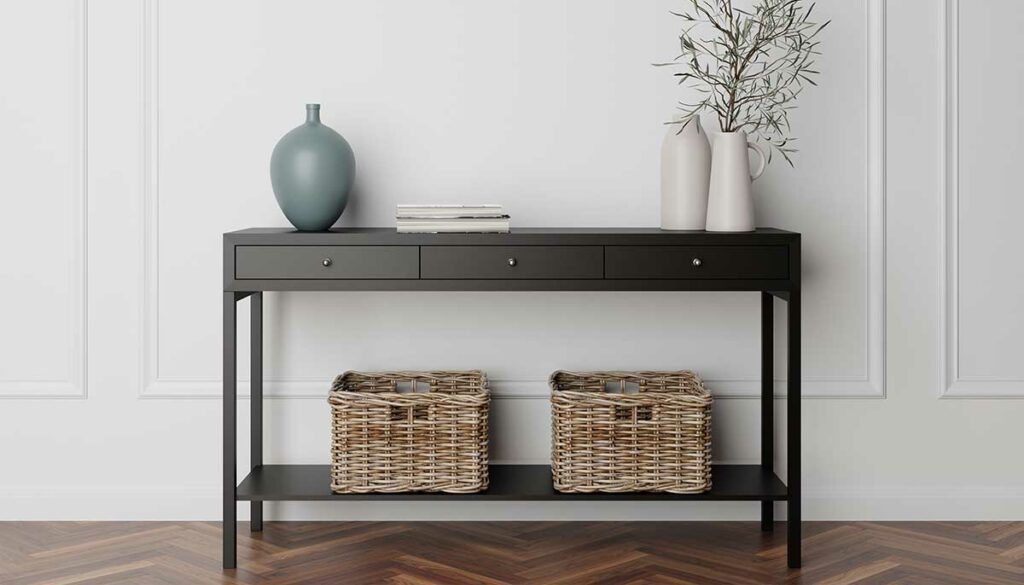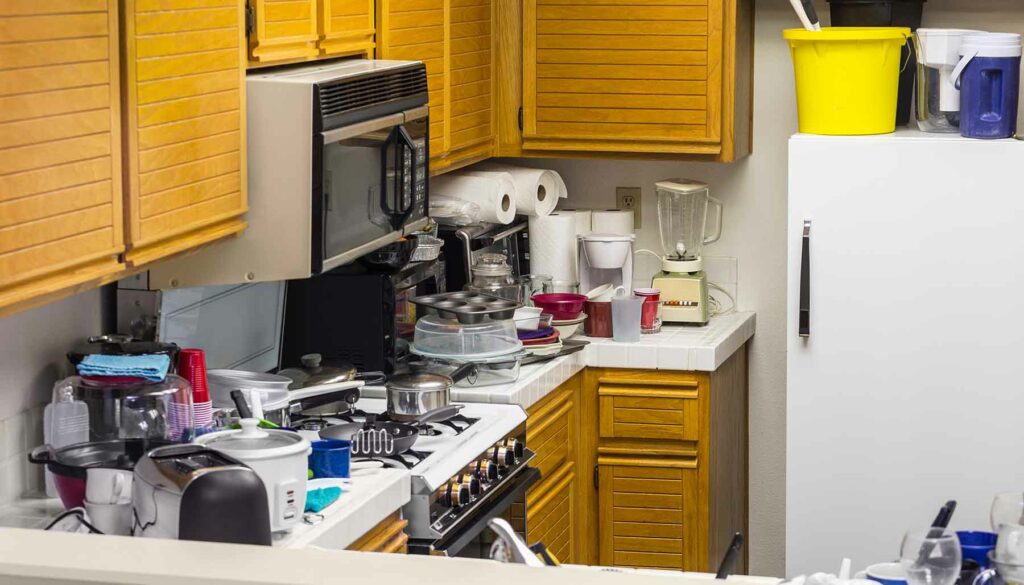You’ve just finished picking up the living room, the dishes are washed, and you even made your bed this morning. So, why does your home still feel messy?
If you’re having a hard time relaxing because your space feels disorganized, no matter how much you clean, it could be due to visual clutter.
Related: 21 Things You Forgot to Clean
Pesky visual clutter could be preventing you from feeling at ease and instead leaving you feeling stressed out and overwhelmed. But before we can correct the problem, we’ve got to talk about it first!
What Is Visual Clutter?
You may have heard the term “visual clutter” a lot by now, but what is it exactly? It’s pretty much just like it sounds. It’s all the stuff hanging around that we can see. Visual clutter includes any items that we leave out on shelves, countertops, and other surfaces. It can also include pictures hanging on the walls, throw pillows and blankets on the couch, your keys and sunglasses on the mantle, and – don’t shoot the messenger here – the crowd of houseplants you’ve collected.

I’m not here to judge. In fact, I have a habit of creating plenty of visual clutter, myself.
All of these items within your vision are of varying sizes, shapes, and colors. Separately, these items are all pretty harmless. But, when there’s too much of it, it turns into too much visual clutter. It can leave your space looking disorganized and messy, no matter how many times you tidy up. And, it can leave you feeling overwhelmed.
You may not even be aware of it, but it can still be affecting your mood. Being surrounded by too much visual information can increase your stress levels and anxiety. It makes your brain think there’s too much to do, even if you’re not consciously thinking about all that stuff around you.
If you or anyone else in the household has ADHD or other attention issues, visual clutter can exacerbate symptoms and make it nearly impossible to function.
Visual clutter can also be costing you money and time. Buying all the things that contribute to visual clutter becomes expensive. But, did you know that visual clutter can be costing you extra time, too? It happens in two different ways. First of all, those extra items require extra cleaning. Not only do you have more surfaces, nooks, and crannies to dust and wipe down, but you also have to move all the items in order to clean whatever they are sitting on. But visual clutter can also make it difficult for you to find what you need. While too many pictures on the wall won’t make it hard to find your car keys, that pile of books and magazines on the table might.
Clearly, we need to reduce the amount of visual clutter around us. It can be in your home, in your office, and even in your car. So let’s talk about some of the ways you can cut down on the visual clutter. You don’t even have to get rid of everything you own and become a minimalist!
Identify the Clutter
Before you can reduce the visual clutter in your space, you have to identify it first! Take a look at your surroundings. Do you have magazines piled up on the coffee table or too many papers stuck to the front of the fridge? Are shelves packed full of knick-knacks, and how many small appliances are taking up precious countertop space?

Here are some of the most common places where visual clutter can be found, and are great places to start:
- Kitchen and bathroom countertops
- Bookcases and shelves
- Coffee tables, end tables, and nightstands
- The entryway
Start Small
If you’re looking around at all the visual clutter and realizing there’s more to do than you thought, it’s okay. Just start small. Trying to fix an entire house at once would be impossible for just about anyone. It needs to be broken up into more manageable pieces.
Pick a single area to start, and focus only there. It can be your desk, the top of your dresser, a coffee table, the kitchen counter, a shelf, or anywhere else where stuff has accumulated. Commit to that one spot. This can be especially effective for busy people without a lot of extra time to declutter.
Group Items By Color
With areas like shelves and bookcases, we usually have a lot of different kinds of items. They might be different sizes and have different uses; some may be decorative while others are utilitarian. Getting rid of some things is an obvious way to reduce visual clutter here, but you can also group items to help make them less visually distracting.
Let’s think about books, for example. Having a bunch of different books on a shelf, with different sizes, fonts, and colors, can be a lot visually. By grouping the books into blocks of color, the books look less scattered and busy. They look like they intentionally go together, and it flows better visually.
Boxes, Bins, and Baskets

Don’t want to get rid of things? Good thing we’re just combatting visual clutter! You are about to be best friends with the three B’s: boxes, bins, and baskets. Neat storage that hides things will do wonders for clearing up visual clutter. It makes everything look much neater and visually pleasing than things just piled up in the open.
Which of these you choose to stash your things in will depend on your personal taste and your space. But these storage solutions can help neaten up bookcases, shelves, closets, cabinets, and more. I actually even have short storage bins meant for under the bed hidden under my couch. It’s where I keep excess throw blankets to reduce visual clutter when they’re not being used.
Create Designated Drop Zones
Home entryways end up so cluttered because most people walk in and drop everything. I mean, where are you supposed to keep your keys, sunglasses, bookbags, and purses? Doesn’t everyone leave their shoes beside the door? (No, actually.)
It’s time to wrangle all of that visual clutter so it doesn’t assault your eyes when you first walk in – plus, it would probably be nice to actually find your keys when you need them.
Small items, like keys and sunglasses, are easier to deal with. You can have a small dish by the door to toss your keys in, but make it a point to never store anything else in here. No rings, no loose change, nothing! The rest of those small things go in one of your boxes, bins, or baskets, which can be tucked onto a shelf, into a drawer, or into a closet.
Storage for larger items, like shoes and bags, will depend on your home. Personally, I have a shoe cabinet near the front door and a hook for bags behind a closet door. If you enter through a garage, this is a great place for a large basket to contain shoes. But I think you get the idea here: these piles of items need to be removed from sight.
Consider the Decor
I can’t tell you how to decorate your home, but I can suggest that you take a step back and really assess how you decorate. Is there too much going on?
Again, you don’t have to be a minimalist to reduce visual clutter, but you do need to wrangle it in just a bit. If there are too many colors and patterns in one room they will compete with each other. Similarly, too many decorative items – like vases, picture frames, and tchotchkes – will compete for your eye. If there are too many, it might be time to pare it down.
Rotate items you love with the seasons, keeping things stored in the attic when not on display. Paint your walls a neutral color if you love bright drapes and furniture. And if you have a big statement-making gallery wall, you’re going to have to tone down the number of items in the room to balance out all the items on the wall.
Clear the Kitchen Counter

This can be particularly difficult for people with tiny kitchens, but all the stuff on the kitchen counter has to go. Not only is it visual clutter that can overwhelm you, but it also tends to make your kitchen look and feel smaller.
While you can’t really do anything about the countertop microwave, other small appliances are best stored behind closed doors: in a cabinet, a pantry, or a closet. Appliances you only use for special occasions can go in the attic or other storage that is less accessible on a daily basis. Try finding drawer space for utensils and knives.
And here is one that everyone needs to hear: stop dropping keys, bills, documents, pens, and other non-kitchen items on the counter and promising to come back to them later! Find somewhere that those items belong, and put them there.













